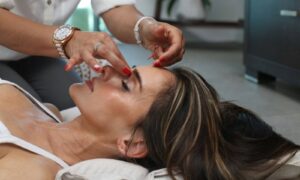Botox is a drug used to weaken or paralyze muscles. It is a toxin, but depending on the dose, it can reduce wrinkles on the skin and treat some medical conditions. In the cosmetics industry, Botox is used as an injectable muscle relaxer by Dermatologist in Karachi, reducing the appearance of wrinkles on the skin. On the other hand, in the medical field, it can be use to treat a number of conditions. It is a protein from Botulinum toxin, which is produce by bacteria.
Cosmetic Uses
Botox injections are one of the most popular cosmetic procedures in the world. Their effect is temporary, lasting for a year or two, and because of this, it is a viable option for many people. However, depending on the treatment, effects can be prolonged. Most commonly, people get botox injections in these areas of the face:
- Lines at corners of the mouth
- Wrinkles around the eyes
- Wrinkles between the eyebrows (the glabellar region)
- Forehead, targeting the horizontal creases
- Cobblestone skin on the chin
Procedure
You must be wondering what actually happens when you get these injections? Well, Botox injections work by temporarily blocking nerve signals and muscle contraction. When you’re unable to move these muscles, the wrinkles can’t be formed. The process is rejuvenating and minimally invasive. First, the doctor may numb the area that is to be injected. They can do so in three ways:
- Topical anesthesia
- Vibration anesthesia
- Ice
Then they proceed by using a thin needle to inject small amounts of botulinum toxin in the skin or muscles. The number of injections depend on the area being treated and the amount required. After the treatment is done, it is advisable to not rub or massage the injected area for at least 24 hours. This prevents the toxin from spreading into other areas. If this is something you’re looking for, go to a Dermatologist in Islamabad for proper advice and administration of the treatment.
Side Effects
The procedure of a botox treatment is short and lasts about ten minutes. For some people, minor bruising or discomfort may occur, but it usually fades after a day or two. Some other side effects of botox injections are:
- Double vision
- Dry eyes
- Swelling or drooping in the eyelid area
- Headache
- Neck pain
- Tiredness
You can also have allergic reactions such as rashes, itching or asthma symptoms. So make sure to check with your doctor before and after the process.
Medical Uses
In medicine, Botox injections can treat the following health issues:
- Lazy Eye
This is caused by an imbalance in the muscles that are responsible for positioning the eye. Botox injections can fix lazy eye by temporarily relaxing those muscles.
- Hyperhidrosis
This condition results in excessive sweating even though the temperature might not be hot, and you’re not exerting yourself.
- Bladder Dysfunction
Botox injections can help treat some bladder disorders by reducing urinary incontinence that is cause by an overactive bladder.
- Cervical Dystonia
This is an excruciatingly painful medical condition where your neck muscles contract involuntarily. The action can cause your head to move into an uncomfortable position.
- Chronic Migraine
Chronic migraines are categorize by the frequent occurrence of migraines for more than fifteen days a month. Botox injections help by reducing the frequency of headaches.
- Muscle Contractures
Neurological conditions like cerebral palsy can cause your limbs to pull in towards the center. Botox injections can help by relaxing those contracted muscles.
- Eye Twitching
If your eyes twitch a lot, Botox injections can help by relieving contracture of the muscles around the eye.
Side Effects
Although Botox injections are mostly safe when administered by trained professionals, there can still be complications. These include:
- Headache
- Dizziness
- Nausea
- Flu-like symptoms
- Dryness in the eye
- Drooling
- Pain, bruising or swelling at the injected area
- Crooked smile
In some rare cases, individuals can also experience the Botox toxin in the injection to spread around the body. This can be dangerous, so if you notice below mentioned symptoms after getting a botox treatment visit your doctor immediately.
- Trouble speaking
- Difficulty swallowing
- Loss of bladder control
- Vision problems
- Breathing problems
- Muscle weakness
Botox injections begin working one to three days after treatment. Since they are temporary, you need to schedule follow-ups to maintain their effects. Doctors generally recommend avoiding Botox if you are:
- Pregnant
- Breast-feeding
- Allergic to the protein present in cow’s milk



































